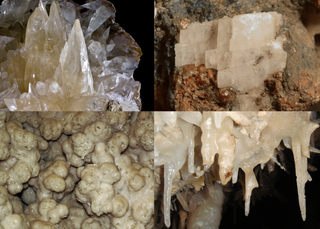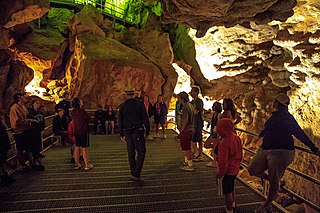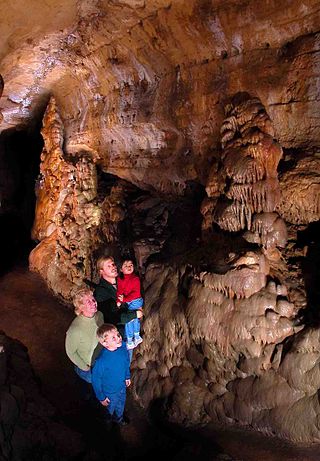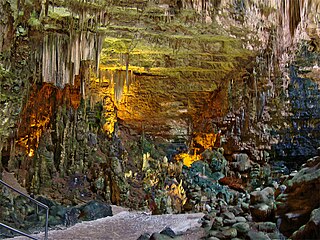
Snowy River Cave Passage is a cave passage within Fort Stanton Cave in Lincoln County, New Mexico, obtaining its name from a stream bed of white calcite.

Snowy River Cave Passage is a cave passage within Fort Stanton Cave in Lincoln County, New Mexico, obtaining its name from a stream bed of white calcite.
The bed of Snowy River is covered with bright white calcite. Over time, ancient, slow moving ground water dissolved the limestone walls of the cave and, with the help of microorganisms, recrystallized limestone into the white-colored mineral. Since prehistoric times, ground water saturated with dissolved calcite has periodically flooded the cave, followed by extended periods of dryness, leaving behind coatings and deposits. Fort Stanton Cave, now including the Snowy River Passage, contains the fourth largest cave footprint (the area within a convex polygon that encloses the known cave passages) in the USA.
The Bureau of Land Management reports that Snowy River may be the largest continuous cave formation in America.
Discovered in 2001, Snowy River is a section of a much larger cave complex. Researchers and explorers have not yet determined how the formations relate to the geology and hydrology. After visits to the dry riverbed in 2001, 2003 and 2005, explorers were surprised to find Snowy River flowing with water in 2007 and also in 2010 after a heavy winter snowfall. In 2014, cave surveys reached points as far as 12 miles (19.3 km) from daylight from the cave's single entrance. In August 2014, Snowy River again started flowing and continued to flow for the next three years, severely limiting exploration far upstream past Midnight Junction where a camping area had been established. With surveyed passage reaching 31.59 miles (50.84 km) in 2017, this cave is the third longest cave in New Mexico. At 11 miles, Snowy River is the world's longest calcite formation. The non-profit [1] group has a long history of work in the cave, and in 2017 published a new book 12 Miles From Daylight with over 300 pages and 350 photographs and maps, featuring explorations from 1855 to the present.
From crusts on the cave walls, antibiotic-producing actinobacteria and some 36 strains of manganese-using bacteria have been discovered. New Mexico Institute of Mining and Technology says the organisms live in this isolated environment by chemically breaking down manganese compounds, [1] [2] creating reconstituted mineral byproducts in the process that may have pharmaceutical uses. Scientists anticipate new biological as well as geologic discoveries will be found.

A cave or cavern is a natural void in the ground, specifically a space large enough for a human to enter. Caves often form by the weathering of rock and often extend deep underground. The word cave can refer to smaller openings such as sea caves, rock shelters, and grottos, that extend a relatively short distance into the rock and they are called exogene caves. Caves which extend further underground than the opening is wide are called endogene caves.

Limestone is a type of carbonate sedimentary rock which is the main source of the material lime. It is composed mostly of the minerals calcite and aragonite, which are different crystal forms of CaCO3. Limestone forms when these minerals precipitate out of water containing dissolved calcium. This can take place through both biological and nonbiological processes, though biological processes, such as the accumulation of corals and shells in the sea, have likely been more important for the last 540 million years. Limestone often contains fossils which provide scientists with information on ancient environments and on the evolution of life.

A stalactite is a mineral formation that hangs from the ceiling of caves, hot springs, or man-made structures such as bridges and mines. Any material that is soluble and that can be deposited as a colloid, or is in suspension, or is capable of being melted, may form a stalactite. Stalactites may be composed of lava, minerals, mud, peat, pitch, sand, sinter, and amberat. A stalactite is not necessarily a speleothem, though speleothems are the most common form of stalactite because of the abundance of limestone caves.

Calcite is a carbonate mineral and the most stable polymorph of calcium carbonate (CaCO3). It is a very common mineral, particularly as a component of limestone. Calcite defines hardness 3 on the Mohs scale of mineral hardness, based on scratch hardness comparison. Large calcite crystals are used in optical equipment, and limestone composed mostly of calcite has numerous uses.

Travertine is a form of terrestrial limestone deposited around mineral springs, especially hot springs. It often has a fibrous or concentric appearance and exists in white, tan, cream-colored, and even rusty varieties. It is formed by a process of rapid precipitation of calcium carbonate, often at the mouth of a hot spring or in a limestone cave. In the latter, it can form stalactites, stalagmites, and other speleothems. It is frequently used in Italy and elsewhere as a building material. Similar deposits formed from ambient-temperature water are known as tufa.

Wind Cave National Park is an American national park located 10 miles (16 km) north of the town of Hot Springs in western South Dakota. Established on January 3, 1903 by President Theodore Roosevelt, it was the sixth national park in the U.S. and the first cave to be designated a national park anywhere in the world. The cave is notable for its calcite formations known as box work, as well as its frostwork. Approximately 95 percent of the world's discovered box work formations are found in Wind Cave. The cave is recognized as the densest cave system in the world, with the greatest passage volume per cubic mile. Wind Cave is the seventh longest cave in the world with 154.2 miles (248.16 km) of explored cave passageways and the third longest cave in the United States. Above ground, the park includes the largest remaining natural mixed-grass prairie in the United States.

Jewel Cave National Monument contains Jewel Cave, currently the fifth longest cave in the world, with 215.05 miles of mapped passageways. It is located approximately 13 miles (21 km) west of the town of Custer in Black Hills of South Dakota. It became a national monument in 1908.

At 150.4 miles (242.0 km), Lechuguilla Cave is the eighth-longest explored cave in the world and the second deepest in the continental United States. It is most famous for its unusual geology, rare formations, and pristine condition.

Dolomite (also known as dolomite rock, dolostone or dolomitic rock) is a sedimentary carbonate rock that contains a high percentage of the mineral dolomite, CaMg(CO3)2. It occurs widely, often in association with limestone and evaporites, though it is less abundant than limestone and rare in Cenozoic rock beds (beds less than about 66 million years in age). The first geologist to distinguish dolomite rock from limestone was Belsazar Hacquet in 1778.

Flowstones are sheetlike deposits of calcite or other carbonate minerals, formed where water flows down the walls or along the floors of a cave. They are typically found in "solution caves", in limestone, where they are the most common speleothem. However, they may form in any type of cave where water enters that has picked up dissolved minerals. Flowstones are formed via the degassing of vadose percolation waters.

Cave of the Mounds, a natural limestone cave located near Blue Mounds, Wisconsin, United States, is named for two nearby hills called the Blue Mounds. It is located in the southern slope of the east hill. The cave's beauty comes from its many varieties of mineral formations called speleothems. The Chicago Academy of Sciences considers the Cave of the Mounds to be "the significant cave of the upper Midwest" because of its beauty, and it is promoted as the "jewel box" of major American caves. In 1987, the United States Department of the Interior and the National Park Service designated the cave as a National Natural Landmark.

Optymistychna is a gypsum cave located near the Ukrainian village of Korolivka, Chortkiv Raion, Ternopil Oblast. Approximately 264 km (164 mi) of passageways have been mapped within. As a result, it is the longest cave in Eurasia and the sixth-longest cave in the world, after Mammoth Cave, Sistema Sac Actun, Jewel Cave, Shuanghedong and Sistema Ox Bel Ha. It is also the longest gypsum cave in the world.

The Castellana Caves are a karst cave system located in the municipality of Castellana Grotte, in the Metropolitan City of Bari, Apulia, southern Italy.
The Caves of the Tullybrack and Belmore hills are a collection of caves in southwest County Fermanagh, Northern Ireland. The region is also described as the West Fermanagh Scarplands by environmental agencies and shares many similar karst features with the nearby Marble Arch Caves Global Geopark.

A solutional cave, solution cave, or karst cave is a cave usually formed in the soluble rock limestone. It is the most frequently occurring type of cave. It can also form in other rocks, including chalk, dolomite, marble, salt beds, and gypsum.
The Fort Stanton–Snowy River Cave National Conservation Area is a National Conservation Area in the eastern foothills of the Sierra Blanca, between Capitan and Lincoln in south central New Mexico. Including approximately 25,080 acres (10,150 ha) and located at an elevation of about 6,300 feet (1,900 m) above sea level. It was established in 2009 to protect, conserve, and enhance the unique and nationally important historic, cultural, scientific, archaeological, natural, and educational cave resources of the Fort Stanton–Snowy River cave system.

El Soplao is a cave located in the municipalities of Rionansa, Valdáliga and Herrerías in Cantabria, Spain. It is considered unique for the quality and quantity of geological formations (speleothems) in its 17 miles length, 6 of which are open to the public. In it are formations such as helictites and curtains. Its formation dates back to the Mesozoic, in particular the Cretaceous period 240 million years ago. The entrance is at 540 metres in the Sierra Soplao Arnero.

The Wellington Formation is an Early Permian geologic formation in Kansas and Oklahoma. The formation's Hutchinson Salt Member is more recognized by the community than the formation itself, and the salt is still mined in central Kansas. The Wellington provides a rich record of Permian insects and its beddings provide evidence for reconstruction of tropical paleoclimates of the Icehouse Permian with the ability in cases to measure the passage of seasons. Tens of thousands of insect fossil recovered from the Wellington shales are kept in major collections at the Harvard Museum of Comparative Zoology and Yale Peabody Museum of Natural History.
İnsuyu Cave is a show cave situated near Burdur in southwestern Turkey. Being over 500 m (1,600 ft) in length, it was discovered in 1952 and opened to public in 1965. A second cave beyond the show cave was later discovered. The lakes inside the both caves are in danger of drying due to excessive drilling of wells in the valley above. However, efforts are underway to reverse the process.

Indiana Caverns is part of the Binkley Cave system near Corydon, Indiana.